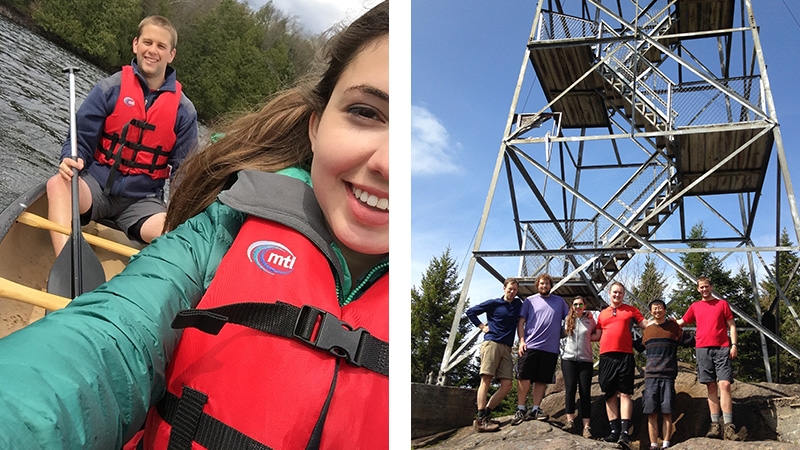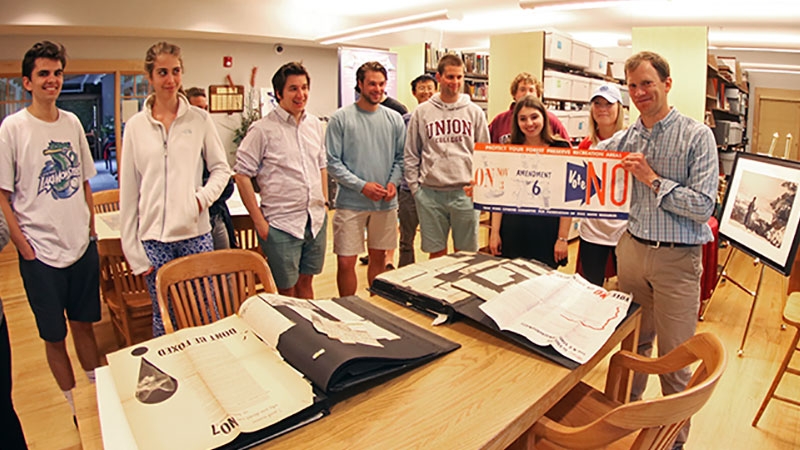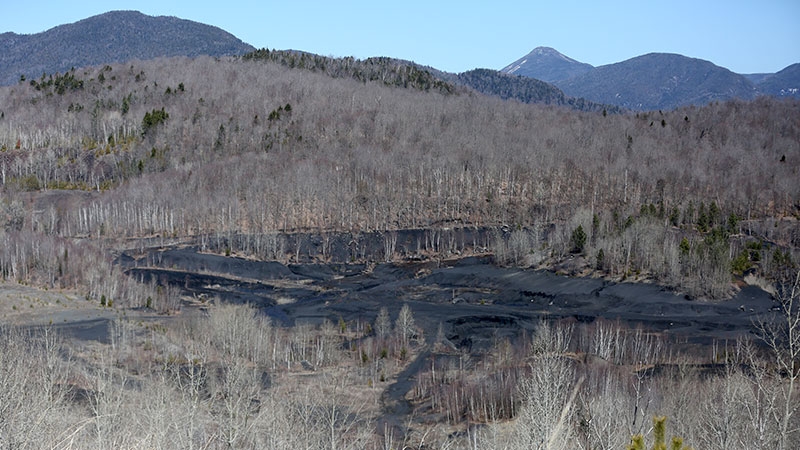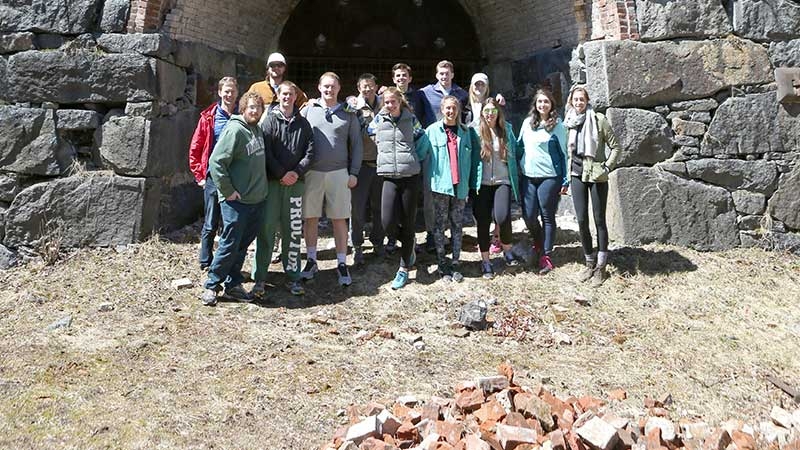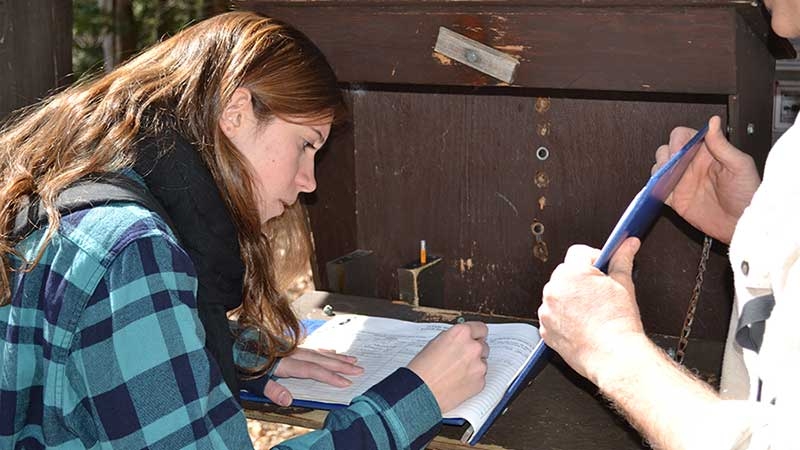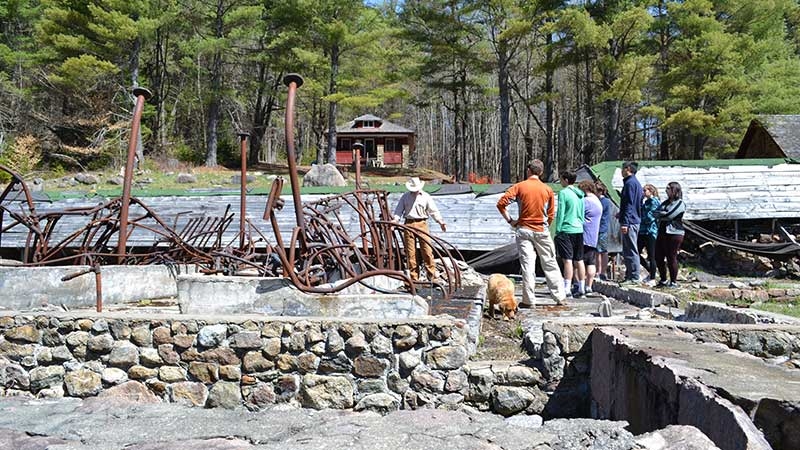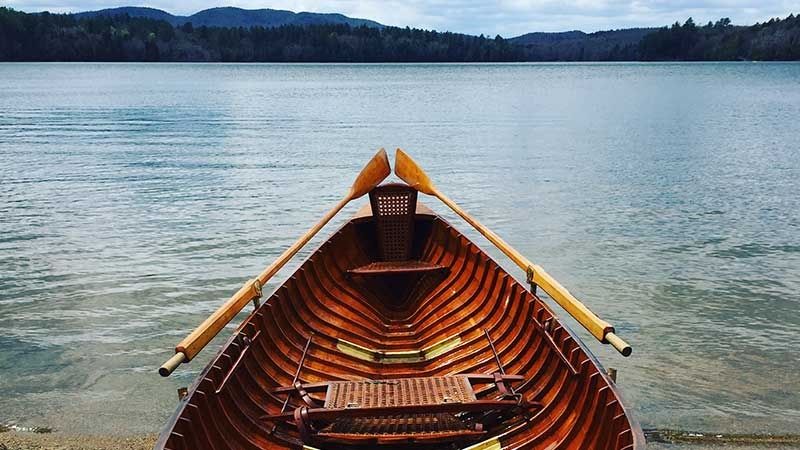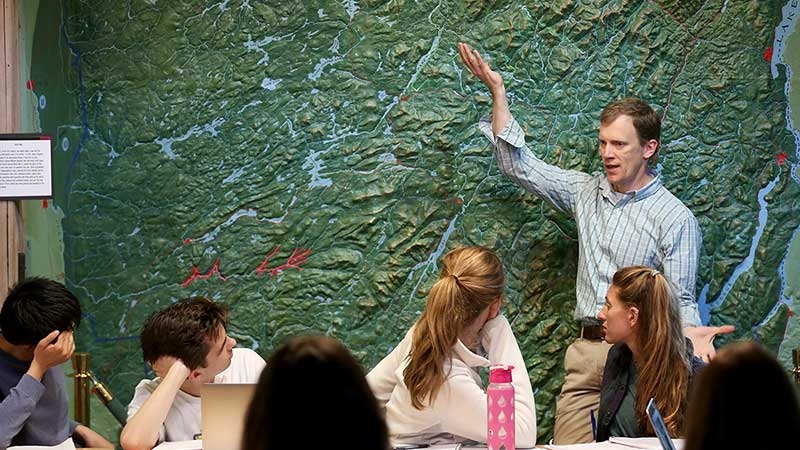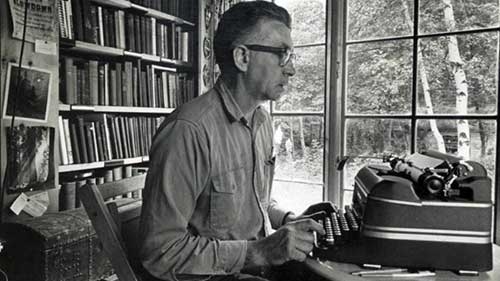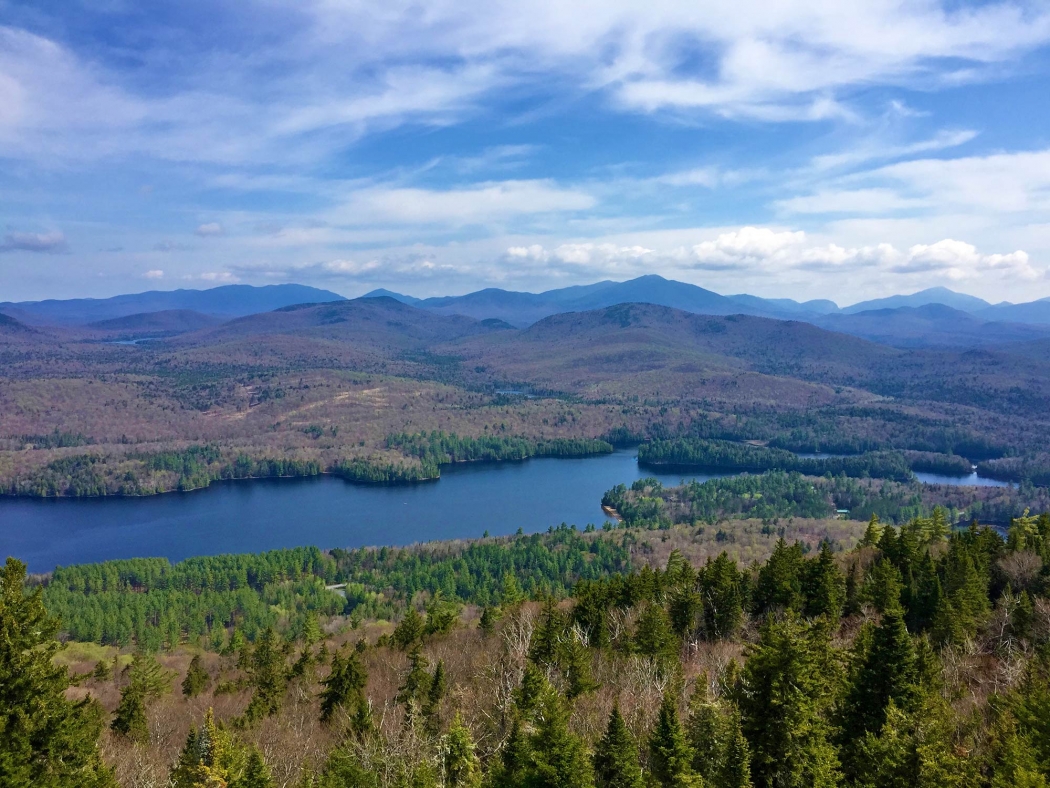
“I heard a rumor this was going to be a really fun class.”
That’s why Chris Graff ’16 signed up for the inaugural “Adirondacks and American Environmental History” course this spring. Well, that and – as a European history major – he wanted to take at least one American history class before graduating.
Either way, the course didn’t disappoint. Developed by Associate Professor of History Andrew Morris, it makes a case study of Adirondack environmental history within the context of broader American environmental history.
Some of the fun included a field trip to an Adirondack ghost town and an abandoned iron works, a 5-mile trek (one way) to a stunning lake and 19th-century great camp, and an overnight adventure with paddling, s’mores and a hike to an old fire tower (and some quintessential black flies, too).
“The field trips really helped give me a greater appreciation for the region,” Graff said, “especially since I had very little experience with the Adirondacks before the course.”
And that’s exactly why Morris incorporated them.
“That sense of place was really important in the development of different attitudes toward the Adirondack environment and region,” Morris said. “It was vital to get students up there so they could have their feet on the ground and the landscape in their memories.”
Henry Scherck ’16 certainly won’t forget the hike to Santanoni, a great camp near Newcomb, N.Y.
“Some of my most poignant experiences at Union have been labs – I’ve been able to go into caves and study volcanoes,” said Scherck, who majored in political science and classics. “I feel like labs are what’s missing from the humanities and social sciences.”
“But you get that with this class. You get to go to the Adirondacks. Santanoni is art. It’s hard to imagine what that is without being there. You can really feel it, standing there. It’s just you and that history, nothing else to distract you.”
Back in Schenectady, class met at the Kelly Adirondack Center. Formerly the home of conservationist Paul Schaefer, it was purchased by Union in 2011 with a gift from John E. Kelly III ’76.
The seminar course investigated how the perception, utilization and protection of the Adirondacks was shaped by a variety of cultural and economic values. As a result, students studied everything from mining and logging to tourism and the rise of the automobile, to public and environmental policy, to forest management and conservation, to men like Paul Schaefer and Teddy Roosevelt.
“This may seem daunting when you realize you have to cover all these various topics, but I would argue its essential,” Graff said. “Without at least touching on each topic, it would be hard to understand the whole history of the Adirondack region.”
As a result of this interdisciplinary nature, the course attracted a diversity of students.
“We had history majors, environmental science and policy majors, political science majors, engineering majors and even one Spanish major,” Graff said. “This diversity really contributed to the interesting discussions we had, and it helped me gain a more well-rounded view of the material.”
Part of Union’s growing Adirondack initiative, which includes the Kelly Adirondack Center and annual Adirondack Week, the class adds an important element to the College’s efforts.
“It serves the broader hope of the program – that we will really get our students thinking of the Adirondacks as part of the Union experience,” said Morris, who co-chairs the faculty advisory committee for the center. “That we will get them to forge real connections to the Adirondacks.”
His students, at least, took something away from this class that will stay with them.
“I never knew the impact the Adirondacks have had in environmental politics and how complex the fight for the forest preserve and park have been,” said Anouk Nouet ’18, an environmental science major. “I have always been interested in environmental law but, in taking this class, I am sure that I would like to pursue this kind of career.”
And for Scherck, the class helped him understand a place he used to call home. A former resident of Great Sacandaga Lake, just inside the Adirondack Park boundary, he was never really sure what to make of the Adirondack Park.
“It always seemed like half a park to me. We owned land, so it’s not like Yosemite,” he said. “So what exactly is it? This class really clarified that on a constitutional and statutory level.”
Herewith is just a glimpse of some of the other interesting history Scherck and his classmates learned.
Early industrial history (1800s-1890s)
“Up until the early 1800s, nobody thought the Adirondacks were good for much of anything. The landscape also discouraged settlement. It was very rough for what was primarily an agricultural society,” Morris said. “People went for greener grass, literally. It was also economically and technologically unfeasible to make much use of the multitude of timber.”
So the Adirondacks remained relatively unexplored until the 1820s, when technologies like the steam boat and railroad made it possible for remote regions to be integrated into the growing, industrializing national economy, Morris said.
A growing economy that saw these regions as repositories of near limitless resources.
“Nature was seen almost exclusively as something to be utilized for the growth of human societies,” Morris explained. “In the Adirondacks, it was the bark from hemlock trees – an essential ingredient in the tanning process for leather – that was the first to be intensively exploited.”
Then came mining, mostly for iron ore, and logging for timber.
Most mining took place on the eastern edge of the Adirondacks, where the ore could be floated out on Lake Champlain and taken to market, Morris said. That wasn’t the case for the Adirondack Iron Works, which Morris’s class visited. Situated in the mountainous interior near what is now Newcomb, N.Y., the operation dammed the Hudson River. This made it possible to float iron ore out and move the timber that fed the mine’s charcoal kilns, and built the mining town called Adirondack.
“People were modifying the landscape left and right,” Morris said. “These mining sites left very visible scars on the landscape.”
Some of those scars are still visible at the Adirondack Iron Works, where ore was extracted from McIntrye Mine beginning in 1827. By about 1854, an imposing blast furnace several stories high was built.
“It took one acre of trees to make enough charcoal to fire the furnace for one day,” said Paul Hai, who led the tour Morris’s class took of the site. Hai is program coordinator for the Northern Forest Institute, SUNY ESF, Newcomb campus.
Fortunately for the trees, the Adirondack Iron Works and the Village of Adirondack were abandoned in 1856. Iron impurities, and the failure to run a railroad into the area, made operating in the wilderness too challenging economically. But its remnants are, nevertheless, impressive.
“The size of the furnace shocked me,” Graff said. “We stood at the base of it to take a group picture and all I could think about was how people back in the 1800s could have built such a massive and complex structure that today is still in a very remote location.”
Yet even as these remote locations were being mined and logged, ideas about what all this wilderness was good for were beginning to shift.
Shifting idea of wilderness (1860s-1890s)
“It’s not too long into the early industrial period that we see movement away from this idea of wilderness as a foreboding place that needs to be subdued,” Morris said. “By the 1830s or so, the Hudson River School of artists sees a spiritual power in these landscapes.”
“It’s the idea that this is a place man hasn’t touched, where there is direct evidence of what God originally created on earth. The idea that you can encounter God directly in the wilderness, that you can be spiritually renewed there.”
But the notion that the Adirondacks were good for something other than iron and wood doesn’t become popular until after the Civil War. By then, people of means were looking at wilderness as an attractive place for leisure and physical healing, away from swelling urban centers.
Just between 1860 and 1900, New York City’s population exploded from 1.2 million to 3.4 million
“In the late 1800s, the people who went up to the Adirondacks were members of the wealthy upper class from the cities (mainly New York), who were trying to escape the crowds and garbage,” Graff said. “The fresh air of the Adirondacks was also thought to have positive health benefits, especially for tuberculosis patients, and many sanitariums sprung up in the Adirondacks.”
Another driving factor in this craving to escape urban life were books like those written by William Murray. His Adventures in the Wilderness (or Camp Life in the Adirondacks), was the inspiration for many.
Released in 1869, and republished numerous times, the book “really speaks to this desire for physical adventure, for hunting and fishing,” Morris said. “But it’s also literally a guide book with how-to advice, what-to-take lists, how-to-get-there directions, and railroad timetables.”
Some of those who followed Murray’s advice built their own havens in the Adirondacks. Robert Pruyn, a prominent Albany businessman and banker, built Santanoni, the great camp Morris’s class visited.
Roughly 35 of these sprawling rustic estates (that left little comfort unfulfilled) were built in the Adirondacks. Santanoni, mostly completed by 1892-93, was established after Pruyn amassed some 12,500 acres, according to Adirondack Architectural Heritage.
The retreat included three main groups of buildings: The gatehouse complex boasted a massive stone gateway, a caretaker’s home, and wagon sheds. The farm complex included huge barns, four farmhouses, a stone creamery, chicken house, kennels and smokehouse. The main camp, five miles in from the gatehouse, consisted of a main lodge that was actually six separate buildings. About 1,500 trees were used in its construction.
Much of Santanoni remains in superb condition.
“It made me reminisce, I hadn’t been in the Adirondacks much in six years,” Scherck said. “I hadn’t experienced the level of quiet that you get at Santanoni in a long time. The kind where you can’t hear anything but your own ears ringing and you just bask in the silence.”
Pruyn and his rich peers certainly weren’t roughing it in the woods, but their presence was indicative of this shifting idea of wilderness.
“The great camps demonstrated that the wealthy elite were beginning to value the American landscape,” Graff said. “Rather than spend months abroad in Paris or Rome, families like the Rockefellers, Vanderbilts and Durants constructed rustic palaces in the Adirondacks.”
And in experiencing the Adirondacks, these affluent metropolitans began to see some things that would spark demands for conservation.
The Adirondacks and conservation (1880s-90s)
But early conservation was less about preservation and more about safeguarding the economy that bolstered the fortunes of the urban wealthy.
“Lumber companies devastated large tracts of land,” Graff said. “Movement to protect the Adirondacks wasn’t from some altruistic desire to save nature. People worried that deforestation would damage the Adirondack watershed, which supplied the Hudson River and Erie Canal, two vital transportation highways of the day.”
“Another concern was that the timber would be completely depleted, and some wanted the forest to be managed so it could be lumbered more effectively,” he added.
Theodore Roosevelt, for instance, who is often remembered as “the conservation president,” believed that forests could – and should – be responsibly managed. He also appreciated their scenic and recreational value, something he learned, in part, in the Adirondacks.
“Roosevelt, who was also governor of New York, was involved in the movement in the Adirondacks before getting involved in what was happening on a national level,” Graff said.
In fact, Roosevelt was hiking Mt. Marcy (the highest peak in the Adirondacks), when President William McKinley was assassinated in 1901.
During the 8 years that followed, according to the National Park Foundation, Roosevelt established the U.S. Forest Service, 51 wildlife refuges, 150 national forests and five national parks.
He also added land to Yosemite, originally created as the second national park (Yellowstone was the first) in 1890.
Protections were also given to the Adirondacks in the late 1880s. But they were different. Unlike national parks, logging wasn’t banned outright. Restrictions in the Adirondacks were initially meant to foster a responsible lumber industry, like those applied to national forests.
“The Adirondack Forest Preserve was created in 1885 out of land that New York owned, where cutting of timber would be regulated by the state,” Morris said. “But this didn’t end up working out, there was still a lot of illegal logging.”
“So by 1892, we get the creation of the Adirondack Park,” he continued. “This draws a line around the area the state is most interested in protecting, where the state will concentrate its efforts to acquire lands.”
And this is where it can get confusing. Because unlike national parks – totally public in all aspects – the Adirondack Park is both public and private.
The park – everything inside the so-called blue line – are the private lands the State of New York is most interested in buying and adding to the preserve. (It’s called the blue line, incidentally, because it was originally a line drawn in blue on a map.) The preserve is public land that has New York’s famous “forever wild” protection.
“Because logging abuses still continued after 1892, an amendment to the state constitution was adopted in 1894,” Morris said.
The first two sentences read: “The lands of the state, now owned and hereafter acquired, constituting the forest preserve as now fixed by law, shall be forever kept as wild forest lands. They shall not be leased, sold or exchanged, nor taken by any corporation, private or public, nor shall the limber thereon be sold, removed or destroyed.”
Today, the preserve amounts to 2.6 million acres of the 6 million acre park. And many areas in the park that are privately owned are still open to logging and other industry. But for preserve lands, protection is strict.
The amendment gives New York the distinction of being the only U.S. entity – state or federal – to grant constitutional protection to wilderness.
A protection Paul Schaefer fought his entire life to uphold.
Paul Schaefer: conservation leader (1930s-1996)
A native of Niskayuna, N.Y., Schaefer was a preeminent leader of the Adirondack conservation movement, and builder of the house that is now Union’s Kelly Adirondack Center.
Born in 1909, he grew up in an era of relative prosperity that witnessed the rise of the automobile.
“The 1920s is really an important moment with the expansion of car ownership. Henry Ford’s Model T made cars affordable for more people, not just the wealthy,” Morris said. “So more people began driving to the Adirondacks, to national parks and national forests, and using their cars as part of their outdoor experience.”
In response, New York State developed new trail systems and campsites, which could accommodate cars and car camping (very popular at the time).
“You could argue there was an expanding appreciation for wilderness as more people were able to experience it,” Morris said. “But there was also a growing sense, across the country, that these places were being overrun.”
“Some people involved in the wilderness movement wanted to permanently protect places from these kinds of uses.” he added. “Schaefer really saw himself as a defender of ‘forever wild.’ He believed in wilderness as a place that should be kept primitive. Not motorized.”
Mentored by famed environmental activist John Apperson, Schaefer came into his own after World War II. He made his biggest mark during the Black River Dam Wars, a years-long fight against more than 30 proposed hydroelectric dams in Adirondacks.
One such dam was to be built across Moose River, which begins in the Southwestern Adirondacks. It would have flooded dozens of ponds, rivers and streams, destroying unique boreal habitat for birds and other animals, and submerging arguably the largest winter deer-yarding ground in the region.
By the time Schaefer learned that Gov. Thomas Dewey was going ahead with the project in 1945, fighting it seemed like wasted energy to some of his peers.
“The die were already cast, the permits and approvals already given,” Morris said. “But slowly, Schaefer mobilized people. They did mass letter-writing campaigns, publicity mailings and advertisements. Slowly, they undermined support in the state legislature. By 1956-57, the dam is finally dead.”
It wasn’t just the Moose River dam Schaefer stopped, though, it was all of them. None of the proposed hydroelectric projects ever became realities.
Today, we have the Moose River Plains Wild Forest, 64,322 acres of more than 65 ponds and lakes, 100 miles of streams and rivers, and more than 100 primitive campsites. And as part of the Adirondack Forest Preserve, it’s all forever wild.
“Stopping the Moose River dam is a pretty important moment – the economic use of this land is trumped by recreational and aesthetic uses,” Morris said. “It was a major turning point that was also playing out nationally, with the defeat of the proposed dam in Dinosaur National Monument (Colo.), for instance. Other wilderness values were gaining power.”
Schaefer would go on to be an active participant in the creation of the Federal Wilderness Act of 1964. In 1979, he transformed his private library into the Adirondack Research Library and opened it to the public. The ARL is part of Union’s Kelly Adirondack Center. It’s still open to the public.
And it’s where Morris held class this spring. Their seminar room was dominated by a massive stone fireplace and a wall-to-floor relief map of the Adirondacks.
“We were literally sitting underneath this map that they created to get their heads around the totality of the Adirondack landscape and these areas they perceived as threatened,” Morris said. “A lot of strategizing went on in that room over the years. That room is part of the Adirondack story.”
“Having the research library just across the hall has also been fantastic,” he added. “Students could touch and read original texts by Schaefer and Apperson, and that’s something that’s hard to do in a traditional classroom.”
The non-traditional classroom was definitely a high point for Graff.
“It’s really special to study the history of the Adirondacks and the story of the conversation movement in the very home where a major part of that story was written,” he said. “The Kelly Adirondack Center is a great resource for Union. I’m glad to see it utilized in this new way, and grateful to have been part of the inaugural course taught there.”
